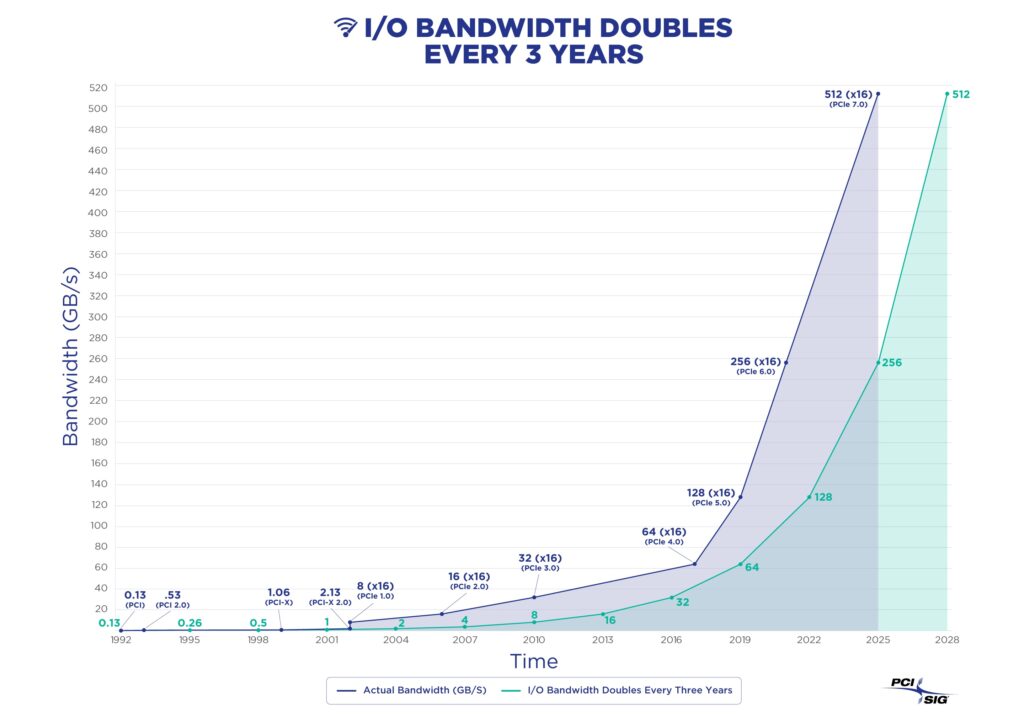The tech industry has received a new boost this week with the official announcement of the PCI Express (PCIe) 7.0 specification by PCI-SIG, the organization responsible for the development and evolution of this standard. The new version, which is now available to its members, promises to take connectivity to unprecedented speeds of up to 128.0 GT/s (gigatransfers per second), positioning itself as a key pillar for applications based on artificial intelligence, 800G Ethernet networks, cloud computing, and quantum computing.
### A Historic Leap in Bandwidth and Efficiency
The PCIe 7.0 specification doubles the bandwidth of the previous generation, reaching up to 512 GB/s bidirectionally in x16 configurations, representing a crucial improvement for data centers and high-performance computing (HPC) systems. To achieve this milestone, PCIe 7.0 incorporates PAM4 (Pulse Amplitude Modulation with 4 levels) and a flit-based encoding system, technologies that are already trending in other areas such as high-speed networks.
The new version also stands out for its improved energy efficiency, a growing need in an environment where electrical consumption and sustainability have become priorities. Additionally, it maintains backward compatibility, easing the transition for companies and manufacturers that have invested in previous generations of the PCIe standard.
### Artificial Intelligence and Cloud as Main Beneficiaries
According to Al Yanes, president and director of PCI-SIG, “PCIe technology has been the preferred high-speed, low-latency input/output interconnection for over two decades, and we are pleased to announce the PCIe 7.0 specification, which continues our tradition of doubling bandwidth every three years.” Yanes adds that the new standard responds to the rapidly escalating demand generated by applications in artificial intelligence, hyperscale data centers, automotive, and strategic sectors such as defense and aerospace.
Ian Cutress, chief analyst and managing director of More Than Moore, highlights the unprecedented enthusiasm that PCIe 7.0 has generated compared to previous versions: “Data centers are ready to deploy PCIe 7.0-based networks, and nearly all ASIC companies are already working with IP vendors to leverage its advantages. The rise of computing and connectivity has brought demand to an all-time high, despite the technical complexity of creating standards around high-speed signals.”
### Optical Interconnection: The Next Frontier
As a noteworthy development, PCI-SIG has introduced an update to the specification to enable optical interconnection through the Optical Aware Retimer Engineering Change Notice (ECN). This advancement facilitates the integration of optical technologies among devices compliant with PCIe 6.4 and 7.0 specifications, allowing for extended reach across racks and pods, and enabling more compact and efficient implementations than traditional copper-based solutions.
The optical retimer will allow for multiplexing and data mapping between electrical and optical domains, paving the way for even more scalable and future-ready data center infrastructures.
### Timeline and Outlook
According to the official timeline, PCIe 7.0 will complete pre-FYI testing in 2027, with the first list of integrators expected in 2028. At the same time, the organization is already working on the future PCIe 8.0 specification, ensuring the continuity of investments and the technological roadmap for the industry.
With this announcement, PCI-SIG reaffirms its leading role in the evolution of global technological infrastructure, consolidating PCIe as the benchmark standard for the challenges posed by the new era of artificial intelligence, big data, and advanced computing.

